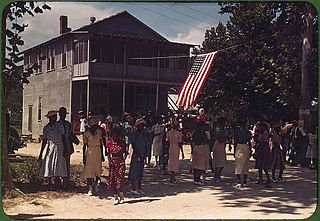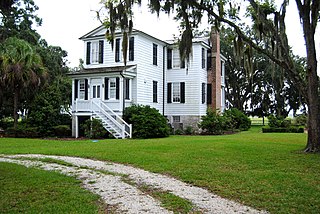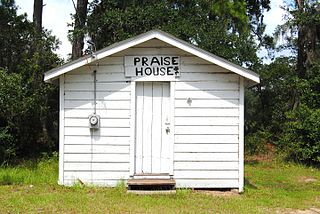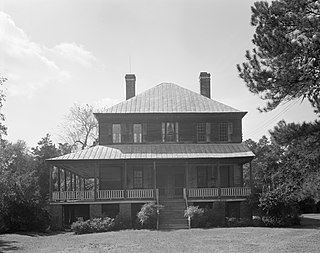
St. Helena Island is a Sea Island in Beaufort County, South Carolina, United States. The island is connected to Beaufort by U.S. Highway 21. The island has a land area of about 64 sq mi (170 km2) and a population of 8,763 as of the 2010 census. It is included as part of the Hilton Head Island-Beaufort Micropolitan Area. The island is renowned for its rural Lowcountry character and being a major center of African-American Gullah culture and language. It is considered to be the geographic influence behind the children's television program Gullah Gullah Island.
Frogmore is an unincorporated community on St. Helena Island in Beaufort County, South Carolina, United States, along U.S. Route 21.

Coffin Point Plantation, is a historic plantation house located in the Frogmore area of Beaufort County, South Carolina, USA. A Sea Island plantation, it profited from the labor of enslaved people.

The Coffin Point Plantation Caretaker's House, located in the Frogmore area of Beaufort County, South Carolina and in the shadows of the nearby Coffin Point Plantation, was built in 1892 as a residence for the plantation's caretaker. The Queen Anne style of architecture is considered marginally interesting, but it is noteworthy in that it is the only home known at this time that employed this style. During this era in the plantation's history, the site primary dwelling was owned by James Donald Cameron, who was the Secretary of War under Ulysses S. Grant, and later, United States Senator from 1877 to 1897. The Coffin Point Plantation Caretaker's House was listed in the National Register of Historic Places on May 26, 1989.

The Frogmore Plantation Complex, located on Saint Helena Island, in Beaufort County, South Carolina, is significant for several reasons. First, the plantation home, along with its contributing properties, offers an excellent example of the area's architectural development from 1790–1920. Second, the plantation's long association with prominent families contributes to its significance. The plantation was first owned by Lieutenant Governor William Bull, who then willed it to his son in 1750.

Emanuel Alston House is a historic home located on Saint Helena Island near Frogmore, Beaufort County, South Carolina. It was built about 1915, and is a rectangular one-story, vernacular frame dwelling on a brick foundation, with a metal hipped roof. The front façade features a full-width porch, with a low hipped roof. A shed or hipped roof dormer located on the front roof slope provides light and ventilation to the attic space.

Dr. York Bailey House, also known as the Sara Rhodan House, is a historic home located on Saint Helena Island near Frogmore, Beaufort County, South Carolina. It was built about 1915, and is a two-story, vernacular frame American Foursquare style dwelling. It was built for Dr. York W. Bailey (1881-1971), a prominent native of the island who was St. Helena's first African-American doctor and only resident physician for over 50 years. He lived in this house until his death in 1971. The York W. Bailey Cultural Center and Museum at Penn Community Center is named for him.
Isaac Fripp House Ruins is a historic house ruin and archaeological site located on Saint Helena Island near Frogmore, Beaufort County, South Carolina. The ruins are located at Bay View overlooking the junction of Chowan Creek and the Beaufort River. The two-story, tabby house dates to the early- to mid-19th century. It is associated with Isaac Fripp, a planter of sea island cotton and other staples on St. Helena Island.

The Corner Store and Office, also known as the Frogmore Emporium, Macdonald, Wilkins, and Company Store and Mark D. Batchelder Office, is a historic general store, residence and, eventually, office building located on Saint Helena Island near Frogmore, Beaufort County, South Carolina. Primarily built as a house, it was built about 1877, and is a two-story, wood-frame building with a gable roof. It features a two-story wraparound porch. The adjacent one-story house was built about 1905. The store sold provisions to the islanders, most of whom were African American, and became one of the major centers of commercial and social activity on St. Helena. The home and businesses in the building were owned by Cameron Thomas and his relatives for most of the 20th century. The family lived in the back and upstairs portion of the house, while the front included a general store and liquor store, with the small house added on used as a residence for relatives. The store also had the only gas pump on the island for many years.
Riverside Plantation Tabby Ruins is a historic archeological site located on Saint Helena Island near Frogmore, Beaufort County, South Carolina. The ruins are significant as an example of early- to mid-19th century tabby construction. The ruins are the remains of an outbuilding associated with the Riverside Plantation and have great archaeological potential.
The Oaks, also known as the Cooler House, is a historic plantation house located on Saint Helena Island near Frogmore, Beaufort County, South Carolina. It was built about 1855, and is a two-story, vernacular frame I-House. Edward L. Pierce chose The Oaks as his headquarters during the military occupation of St. Helena during the American Civil War. The Oaks was the center for military and agricultural activities on the island. On June 18, 1862, Ellen Murray, who had ten days earlier arrived from Pennsylvania, opened the Penn School for Freedmen in a back room of the house. The house also served as a hotel for military personnel from Port Royal, superintendents, and teachers.

Tombee Plantation is a historic plantation house located on Saint Helena Island near Frogmore, Beaufort County, South Carolina. It was built about 1790–1800, and is two-story, T-shaped frame dwelling. It is sheathed in clapboard and has a gable roof. It features a single-story front portico with four square columns and a two-story balustraded rear porch with six square columns on each floor. Along with Seaside Plantation, it is one of the few surviving antebellum plantation houses remaining on St. Helena Island. The Tombee Plantation property was divided into tracts during the days of the "Port Royal Experiment" in 1862. It remained in the hands of descendants of freed slaves until 1971.
Robert Simmons House, also known as the Willie Simmons House, is a historic home located on Saint Helena Island near Frogmore, Beaufort County, South Carolina. The original section was built about 1910 by farmer Robert Simmons, and subsequently expanded. It is a double pen house type on metal piers, with a full-width shed roof porch supported by wood posts. It is a rare example of a vernacular architectural form once common to St. Helena Island.

Eddings Point Community Praise House is a historic church located on Saint Helena Island near Frogmore, Beaufort County, South Carolina. It was built about 1900, and is a narrow, one-story gable roofed building of frame construction with the entrance in the gable end. It is significant as one of four known extant African-American praise houses on St. Helena Island, and was a central place in the religious and social life of the black islanders.

Mary Jenkins Community Praise House is a historic church located on Saint Helena Island near Frogmore, Beaufort County, South Carolina. It was built about 1900, and is a narrow, one-story gable roofed building of frame construction with the entrance in the gable end. It is significant as one of four known extant African-American praise houses on St. Helena Island. The building remains in use.
Orange Grove Plantation is a historic plantation house and national historic district located on Saint Helena Island near Frogmore, Beaufort County, South Carolina. The district encompasses one contributing building and two contributing sites, and reflects the early-20th century influx of Northerners onto St. Helena Island. The plantation was first recorded in 1753 when Peter Perry purchased 473 acres. Perry owned 46 chattel slaves. The plantation house, built about 1800, was in poor condition when Henry L. Bowles (1866-1932), a U.S. Representative from Massachusetts, bought the property in 1928. He demolished it and built the present house in the same year. The property also includes the tabby ruin of the kitchen, built about 1800, and a tabby-walled cemetery containing three early-19th century graves of the Fripp and Perry families.
Pine Island Plantation Complex is a historic hunting plantation complex and national historic district located on Pine Island near Frogmore, Beaufort County, South Carolina. The district encompasses six contributing buildings and one contributing sites, and is an early-20th century hunting plantation. The main house at Pine Island was built about 1904, and is a two-story frame structure built on an existing tabby foundation. The front façade features a full-width two-story porch. Also on the property are the contributing cottage, a toolshed/doghouse, a barn, a pumphouse, an automobile garage, and causeway.

Knights of Wise Men Lodge is a historic clubhouse located on Saint Helena Island near Frogmore, Beaufort County, South Carolina. It was built about 1942, and is a simple, two-story, rectangular cinder block building with a gabled roof. It features a symmetrical, elaborate stepped façade. It was designed by the Lodge brothers and built by local masons, and is located at the rear of The Green. On holidays, the hall was used both as a dance hall and a jail.

Lawson's Pond Plantation is a historic plantation house located near Cross, Berkeley County, South Carolina. It was built about 1823, and is a large two-story clapboard structure set upon high foundations. It has a hipped roof and features a one-story piazza along the front and left facades.

Seaside Plantation House, also known as Locksley Hall, is a historic plantation house located at Edisto Island, Colleton County, South Carolina. It was built about 1810, and is a 2+1⁄2-story, Federal style brick dwelling with a gable roof. The house is one room deep with a long porch across the southeast elevation and sits on a raised basement. The central portion of the house is stuccoed brick with frame additions on the first floor.
















